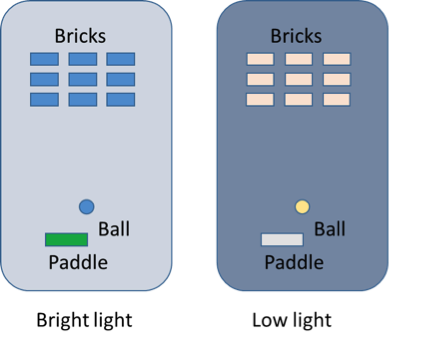This assignment is due by May 5, 2021 by 11:59pm.
For this assignment, make a game or a cool simulation, using sensor data to drive 2D graphics. The only requirement is to use the accelerometer and at least one other type of sensor. We recommending sticking with common sensors that are present on most devices: accelerometer, gyroscope, orientation, and ambient light level.
Below are some ideas for apps that are appropriate. Be creative!
When you create this project, set the domain to include <userName_A4> and name the app <userName>_A4 where userName is your name.
Example I - Marble Madness
We include some additional elements into the simulation of the rolling ball, in the form of two “holes”, drawn as circles on the screen (see figure). One hole is drawn as a green circle, and represents the target that you are trying to maneuver the ball into. The other hole is drawn as a red circle. If your ball goes into the red circle, you lose!
We add a new sensor to measure orientation (i.e., compass heading). When the user rotates the device, the holes rotate in the opposite direction, as shown in the figure. This gives the user additional control over the simulation.

Example II - Breakout / Arkanoid
Recreate the classic game of “Breakout”, which has you hit a ball with a paddle to knock out “bricks”. The accelerometer is used to make the paddle move left and right, by tilting the phone. In addition, we sense the ambient light and draw the screen with a different color scheme depending on whether the light level is high or low.

Part II - Website!
Update the webpage that you submitted with A3 to include an entry for this assignment. As usual, include a screenshot (or two) and a brief description of the program, intended to showcase what your program does to people who are not familiar with the assignment.
Documentation
With this and all future assignments, you are expected to appropriately document your code. This includes writing comments in your source code - remember that your comments should explain what a piece of code is supposed to do and why; don't just re-write what the code says in plain English. Comments serve the dual purpose of explaining your code to someone unfamiliar with it and assisting in debugging. If you know what a piece of code is supposed to be doing, you can figure out where it's going awry more easily.
Proper documentation also means
including a
README.txt
file with your submission. In your submission folder, always include a
file called
README.txt
that lists:
- Your Name / email
- Assignment Number / Project Title
- A brief, high level description of what the program is / does
- A usage section, explaining how to run the program, which keys perform which actions, etc.
- Instructions on compiling your code
- Notes about bugs, implementation details, etc. if necessary
Grading Rubric
Your submission will be graded according to the following rubric.
| Percentage | Requirement Description |
| 20% | App uses two or more distinct sensors |
| 25% | 2D graphics displayed in app |
| 25% | 2D graphics animation driven by sensor movement |
| 25% | Game playable by user or simulation runs continually |
| 5% | Submission includes source code, Android
Studio project, and README.txt. Webpage named
<userName>.html submitted and updated with screenshot from
latest assignment. Submission compiles and executes.
|
Submission
Please make sure your project produces an executable with the name userName_A4. When you are completed with the assignment, zip together your Android Studio project (which includes the Kotlin and XML source code) and README.txt. Name the zip file, userName_A4.zip. Upload this file to Canvas under A4.
This assignment is due by May 5, 2021 by 11:59pm.